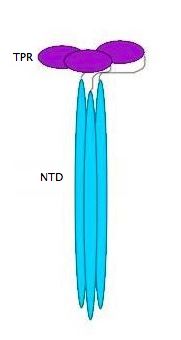YbgF
From Proteopedia
| Line 4: | Line 4: | ||
==Structure== | ==Structure== | ||
YbgF is a periplasmic protein with an N-terminal coiled coil domain (NTD) and a C-terminal tetratricopeptide domain (TPR), both of which are autonomous<ref name='Gerding'>PMID: 17233825</ref>. As seen in the 3D structure 2WZ7, the NTD forms an elongated trimer which is connected via a flexible linker to the TPR trimer, as seen in 2XEV. This connection can be cleaved by proteases<ref name='Krachler'>PMID: 20816983</ref>. | YbgF is a periplasmic protein with an N-terminal coiled coil domain (NTD) and a C-terminal tetratricopeptide domain (TPR), both of which are autonomous<ref name='Gerding'>PMID: 17233825</ref>. As seen in the 3D structure 2WZ7, the NTD forms an elongated trimer which is connected via a flexible linker to the TPR trimer, as seen in 2XEV. This connection can be cleaved by proteases<ref name='Krachler'>PMID: 20816983</ref>. | ||
| - | |||
==Function== | ==Function== | ||
| - | YbgF is | + | Although YbgF is conserved in most gram-negative organisms, the exact function of this protein is still unknown. It may be involved in the late stages of cell division when the Tol complex is recruited to the area of septation, or also during invagination<ref name='Gerding'>PMID: 17233825</ref>. |
| + | |||
| + | It is known that YbgF interacts with the C-terminal domain of TolA during the import of colicin A into the cytoplasm<ref>PMID: 11994151</ref>. The TPR domain in YgbF has been shown to bind to domain II in TolA, with the binding site located between residues 280-313<ref name='Gerding'>PMID: 17233825</ref>. The NTD is not directly involved with the binding to TolA, but is important for the transition of YbgF in its oligomeric state when binding to TolA. This may be due to the NTD restricting the formation of the trimer state, allowing the TPR to bind with TolA<ref name='Gerding'>PMID: 17233825</ref>. | ||
==References== | ==References== | ||
<references/> | <references/> | ||
Revision as of 12:24, 25 April 2011

Template:STRUCTURE 2xev Template:STRUCTURE 2wz7
Structure
YbgF is a periplasmic protein with an N-terminal coiled coil domain (NTD) and a C-terminal tetratricopeptide domain (TPR), both of which are autonomous[1]. As seen in the 3D structure 2WZ7, the NTD forms an elongated trimer which is connected via a flexible linker to the TPR trimer, as seen in 2XEV. This connection can be cleaved by proteases[2].
Function
Although YbgF is conserved in most gram-negative organisms, the exact function of this protein is still unknown. It may be involved in the late stages of cell division when the Tol complex is recruited to the area of septation, or also during invagination[1].
It is known that YbgF interacts with the C-terminal domain of TolA during the import of colicin A into the cytoplasm[3]. The TPR domain in YgbF has been shown to bind to domain II in TolA, with the binding site located between residues 280-313[1]. The NTD is not directly involved with the binding to TolA, but is important for the transition of YbgF in its oligomeric state when binding to TolA. This may be due to the NTD restricting the formation of the trimer state, allowing the TPR to bind with TolA[1].
References
- ↑ 1.0 1.1 1.2 1.3 1.4 Gerding MA, Ogata Y, Pecora ND, Niki H, de Boer PA. The trans-envelope Tol-Pal complex is part of the cell division machinery and required for proper outer-membrane invagination during cell constriction in E. coli. Mol Microbiol. 2007 Feb;63(4):1008-25. PMID:17233825 doi:10.1111/j.1365-2958.2006.05571.x
- ↑ Krachler AM, Sharma A, Cauldwell A, Papadakos G, Kleanthous C. TolA modulates the oligomeric status of YbgF in the bacterial periplasm. J Mol Biol. 2010 Oct 22;403(2):270-85. Epub 2010 Sep 15. PMID:20816983 doi:10.1016/j.jmb.2010.08.050
- ↑ Walburger A, Lazdunski C, Corda Y. The Tol/Pal system function requires an interaction between the C-terminal domain of TolA and the N-terminal domain of TolB. Mol Microbiol. 2002 May;44(3):695-708. PMID:11994151
Proteopedia Page Contributors and Editors (what is this?)
Michal Harel, Laura McCauley, Joel L. Sussman, Alexander Berchansky
